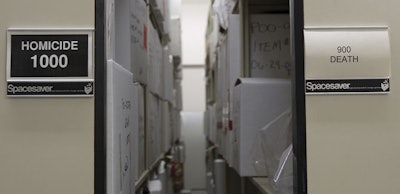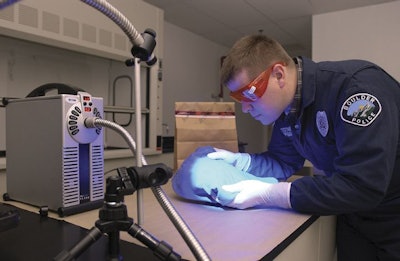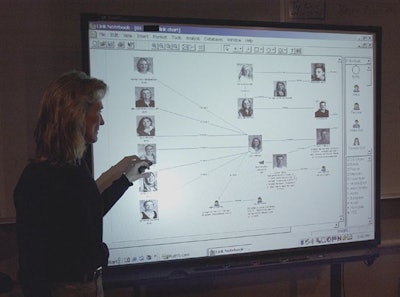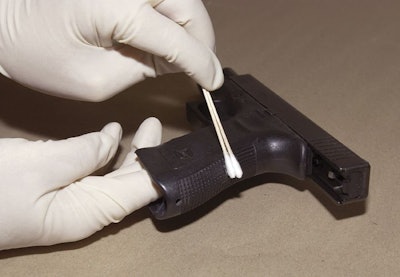A few months ago, newspapers around the country covered the arrest of Gerald Mason for a murder that happened when Dwight D. Eisenhower was in the White House. Mason was rousted out of a comfortable life in South Carolina and charged with killing two police officers in the Los Angeles suburb of El Segundo, Calif., in 1957.
 (Photo: Spacesaver)
(Photo: Spacesaver)
Police contend that on July 22 of that year, Mason kidnapped four teenagers, sexually assaulted one of them, and stole a car. Approximately 90 minutes later Officer Milton Curtis and Officer Richard Phillips of the El Segundo Police Department saw the car run a red light. The two El Segundo officers stopped the car, and the driver shot them both dead. An extensive investigation turned up hundreds of tips, but the killer was never identified, and frustrated El Segundo detectives had to set it aside and move on.
The case of the El Segundo cop killings went cold, but the colleagues of Milton Curtis and Richard Phillips wouldn’t let it die. And a quarter century after the two officers were laid to rest, El Segundo detectives received a tip regarding this case. The lead was false, but it stirred interest in the unsolved murders and the El Segundo PD decided to re-examine the evidence.
Detectives from the Los Angeles County Sheriff’s Department reviewed the evidence from the 1957 crime spree. And they found what they believe to be the key to the case: fingerprints. Forensic technology has changed greatly since 1957 and one of the contemporary tools that cops have now that they didn’t have when cars had tailfins is the fingerprint database.
 Contemporary forensic tools, like this alternate light source, can reveal new evidence from objects in cold case files.
Contemporary forensic tools, like this alternate light source, can reveal new evidence from objects in cold case files.
Using the FBI-administered national fingerprint database, investigators were able to match prints found in the stolen car to Gerald Mason. Mason’s fingerprints were obtained by the FBI in 1956—a year before the murders—when he was arrested for burglary in South Carolina. As a result, Mason, now 69, faces trial on a crime that happened when he was 23.
While the Mason case is an extraordinary example, more and more suspects are facing prosecution for old crimes, as law enforcement agencies around the country use new technology to thaw out cold cases.
FBI Uniform Crime Reports show that under 20 percent of all crime in the United States is cleared by arrest or exceptional means. Fortunately, violent criminals face significantly higher statistics, with a 62.4 percent and 44.3 percent clearance rate for murder and forcible rape, respectively.
In contrast to a less than 20 percent clearance rate for all crimes, the clearance stats for violent crimes look pretty good, until you look deeper. Almost half of all murderers and rapists nationwide are still roaming the streets. What that means for the nation’s overworked criminal investigators and prosecutors is that there are an ample number of cold cases out there that are just waiting to be reopened and solved.
Warming It Up
The cold case investigation process involves assigning detectives to examine cases that went unsolved for various reasons, including: the previously available technology was not advanced enough to analyze the evidence, witnesses were hostile, or the original detectives assigned the case were simply overworked and could not allocate enough time to properly work the case.
Almost every agency in the United States has closed cases that could be reopened and solved. And while you would think that large agencies have the advantage when it comes to allocating resources to cold cases, it’s not necessarily true. Police agencies of all sizes can form cold case squads, either permanently or temporarily, to examine old cases. A larger department might assign more people, but it will also have a large number of cases to investigate. Small departments can assign one or two detectives part time to review a smaller number of cases and may yield better results because the workload is not so overwhelming.
Getting Started
No department has unlimited time, personnel, and resources so it’s important to carefully select the cases for review. Violent persons crimes are particularly well suited to cold case review. The reason for this is simple; homicides and sexual assaults tend to yield the most evidence.
Once the types of crimes that you will be re-examining have been determined, it’s time to define the parameters for selecting specific cases. This will be totally dependent upon the agency and caseload.
For example, it might be reasonable for smaller agencies to look at all unsolved sexual assaults and/or homicides over the last decade. Larger agencies, however, will have to select a limited number of cases based on several factors, including the amount and condition of the physical evidence, the whereabouts of previously identified suspects and witnesses, and the overall severity and brutality of the crime.
If your department has a crime analyst, he or she will be a great resource to help you decide which cases to reopen. Your crime analyst can sort through and filter all reported crimes and give you a list of cases that meet the criteria. If your agency doesn’t have a crime analyst, talk to senior detectives and other long-time personnel. Without a doubt, “old-timers” will remember cases that have gone unsolved for 10, 20, or even 30 years.
Time can be the enemy of some investigations, so ask yourself if the case is too old. A few factors determine whether a case is too old to reopen. First, you need the evidence. So before you reopen a 50-year-old homicide, check with the property and evidence room and see if they still have the physical evidence. Second, you need the parties who were involved in the crime. If you think the key witnesses, victims, and suspects have died, there’s probably little point in reopening the case.
But time can also be an ally. For example, a previously hostile witness may decide the time is right to talk to the police, or a suspect might eventually slip and talk about a crime he committed 10 years ago. Additionally, new fingerprints and DNA profiles are added to federal databases every day. A fingerprint or a DNA sample from a case that’s been dormant for years can receive a hit if the offender is arrested on unrelated charges and his or her fingerprints and/or DNA are entered into the FBI databases.
The Investigation
Digging into a cold case requires patience, diligence, and strong deductive reasoning abilities. You need to approach the investigation with an open mind and the ability to ask certain questions: How has the passage of time changed the case and the persons involved in the case? Why is now the right time to reopen the case? Was the original investigation complete and thorough? What tools and technologies are available now that weren’t available when the case was originally investigated?
The first step—-possibly the most time-consuming step—-is the review of all existing case material, including patrol reports, detective notes, laboratory documents, photographs, crime scene diagrams, witness lists, lead sheets, and suspect information.
 Tracking down the people involved is one of the toughest jobs facing a detective who is working a cold case.
Tracking down the people involved is one of the toughest jobs facing a detective who is working a cold case.
Poring through all this old material can be relatively easy or it can be a nightmare, depending on the condition of the case file. Would you rather reopen a case that’s organized in labeled three-ring binders or one in which all the case materials have been thrown haphazardly into a cardboard box? Keep this in mind if you are working a case that might, at some point, be reopened as a cold case.
Once the file is organized and you understand what investigative work was originally completed on the case, create a to-do list specifying tasks that must be completed. Use this to formulate a case strategy.
The Human Element
The most important components of cold case investigation are the people—victims, witnesses, suspects—and the physical evidence. And no matter how organized the case file, usually some amount of work needs to be completed on the front end to update the witness list. This can be a daunting task. People move, get married, get divorced, get married again, and die.
Fortunately, the Internet offers some powerful tools for investigators. Even basic searches on free Websites such as www.anywho.com and www.qwestdex.com make it easy to locate people. In addition, your agency might want to consider setting up an account with www.flatrateinfo.com or other for-pay Internet search engines. These sites provide information that can’t otherwise be found online. Depending upon the site, you can search credit header information for most recent addresses, voter registration records, county clerk records, liens, foreclosures, marriages and divorces, and many other local, state, and national databases.
Finding people is critical to your success. You will often find that the original investigation left critical questions unanswered. Consequently, many cold cases are solved by conducting additional interviews.
They are also often solved by gathering additional evidence from the witnesses, suspects, and victims. People can voluntarily submit or be court-ordered to submit non-testimonial evidence—fingerprints, DNA, handwriting, etc.
Remember, advancement in all aspects of forensic science is the primary reason why now may be the right time for law enforcement agencies to reopen cold cases. So physical evidence is critical to your success.
Biological Evidence
 No forensic technology has solved more cold cases than DNA matching.
No forensic technology has solved more cold cases than DNA matching.
However, physical evidence presents many challenges to cold case investigation. The newly assigned detectives have no power over how the crime scene was processed and what physical evidence was collected. This alone could grind the investigation to a halt if critical pieces of evidence were overlooked and never collected.
And unfortunately, time is not on our side regarding evidence. Biological evidence may degrade over the years, poor storage of items can result in ruined fingerprint evidence, poorly developed and fixed negatives and photographs may fade, and evidence may have been destroyed or lost by evidence technicians.
This is why one of the most important steps in a cold case investigation is to inventory the available evidence. You need to identify what items are still held as evidence. These items should be inspected and photographed. Once the items are cataloged, laboratory reports should be reviewed to determine what tests have already been completed on the evidence.
Perhaps you’re working on a case from the early ’80s in which serology was completed on a victim’s bloody shirt to determine the blood type of the offender. Now, you need that same bloody shirt for DNA evidence. If the shirt was properly dried and packaged in paper, it’s likely that the DNA will be intact and modern DNA testing can be completed on the item.
It’s important to discuss possible forensic testing with laboratory personnel. The lab technician can determine what type of testing is viable based on the condition of the evidence. Don’t assume that the evidence is no good just because it has been sitting in a property room for years. The FBI has developed comparable fingerprints on many items from the 1940s and DNA evidence is routinely used in cases that are decades old.
But when dealing with the technicians, be patient. Federal, state, and local laboratories are understaffed and overworked. In some states it’s not uncommon to wait over six months for DNA analysis on an active case. So it’s understandable that the laboratories may not give top priority to cold case investigations. Just remember, another six months will probably not have a negative effect on a case that has sat dormant for 20 years.
Prosecution
Consider involving your local prosecutors during the investigative phase instead of dropping the case on their lap at the time of arrest. Working with prosecutors early will help ensure specific tasks that the attorney deems important are completed up-front. This reduces the amount of work that needs to be completed after the arrest or when the case is filed.
Asking the prosecutor to be involved earlier in the process will usually foster a sense of teamwork and make the work proceed more efficiently. Remember, the ultimate goal of cold case investigation is to arrest and convict someone who thinks they are never going to get caught.
Cold case investigation presents many challenges. Adequate resources and personnel are often hard to procure; it can be difficult locating witnesses and suspects, and physical evidence might be degraded or destroyed. Is it worth it? For the answer to that question, all you have to do is consider the El Segundo Police.
Using the Computer
 Analyst’s Notebook software from i2 Inc. can create timelines and help detectives organize complex and confusing information in ways that will help them see the bigger picture of the crime.
Analyst’s Notebook software from i2 Inc. can create timelines and help detectives organize complex and confusing information in ways that will help them see the bigger picture of the crime.
Unsolved violent crimes are often complex, with various people recounting different events and timelines, and it can be difficult for detectives to organize and analyze these crucial aspects of the case. This is why software designed specifically for investigations can be an invaluable aid while working a cold case.
Analyst's Notebook 6 from i2 Inc. (www.i2inc.com) allows investigators to build graphical representations of complex cases that include timelines, relationship charts, and phone and financial records. This software organizes and simplifies data in such a way that it helps you see the case more clearly and make connections that might have otherwise gone unnoticed. In addition to aiding the investigative process, these graphic charts can be critical in the courtroom during prosecution.
And it is being used to great effect by detectives nationwide. For example, detectives from the Gainesville (Fla.) Police Department and a crime analyst from the Georgia Bureau of Investigation recently employed Analyst's Notebook 6 to solve a series of rapes in north Florida and south Georgia.
"As all criminal analysts know, the amount of data and information involved in an investigation such as this one is enormous," says Elaine Posey, a crime analyst with the GBI. "Without the right analysis tools at your fingertips, investigations can take a long time and often lead down the wrong path."
Posey imported all of the seemingly unrelated data from the cases into Analyst's Notebook and created a link analysis chart that showed all of the suspect's associates. She then created a timeline of the suspect's movements and actions and used it to link him to 22 rape cases.
"Within two weeks of using this software, we had hardcore evidence against this suspect," Posey says. "Analyst's Notebook made my job easier, helping us catch a criminal much faster and creating a safer environment for the people of Georgia and Florida."